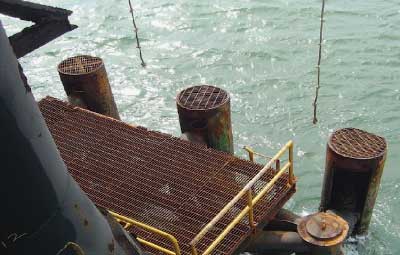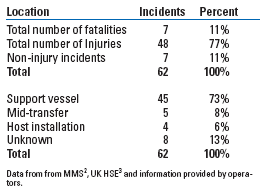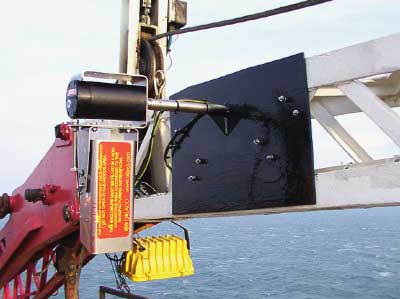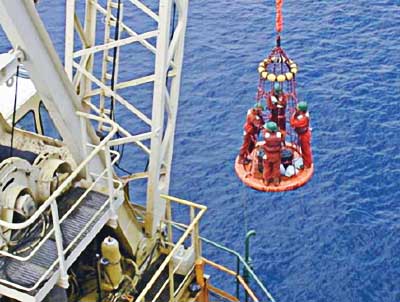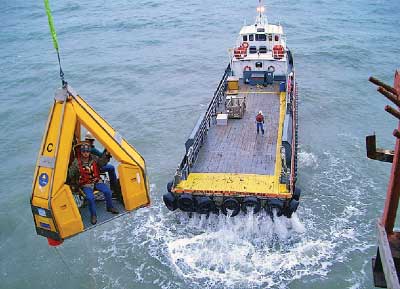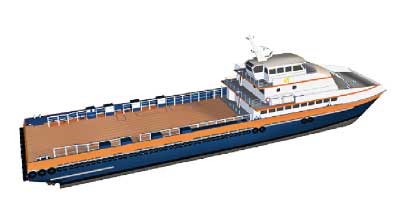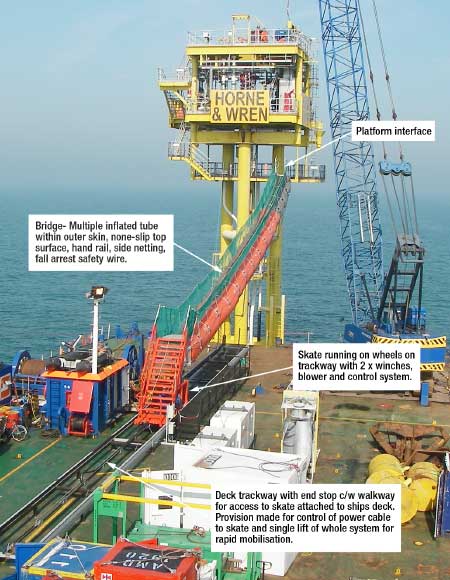Safety in marine personnel transport leaps forward
Transferring people by crane from a vessel to a platform or drillship has always been dangerous. New technology combined with a whole-system approach can lead to dramatic reductions in injury.
Special Focus: HEALTH, SAFETY, ENVIRONMENTSafety in marine personnel transport leaps forwardTransferring people by crane from a vessel to a platform or drillship has always been dangerous. New technology combined with a whole-system approach can lead to dramatic reductions in injury.Perry A. Fischer, Editor It’s been 20 years since this writer was transported from a vessel to a fixed platform or floater. But I did it hundreds of times. Sometimes it was by a swing-rope. Very often, it was by crane via a Billy Pugh personnel net. The situation hasn’t changed much today. Depending on where you are in the world, and where your destination is, these remain the options for transporting personnel offshore from a vessel. Helicopters are by far the safest in terms of injury, but the most dangerous in terms of death. From a vessel, swing-ropes are dismal, safety-wise, but sometimes are the simplest way, logistically, to get on a platform, Fig. 1. As this article points out, crane transfer via a personnel carrier has undergone dramatic change.
It is now becoming more widely recognized in the industry that to carry out crane transfers safely, the whole transfer system must be examined. In terms of hardware, the key system elements are the transfer device, the crane and the vessel. Add in the fact that the crane and the vessel are under control of two different parties-and the passenger is often a third-party contractor-all of which have different work cultures, and you begin to see the picture. Now throw in variables such as weather and human communications, and it becomes clear that what is often viewed as a very basic operation has, in fact, more complexity and nuance than is usually assumed. The Offshore Marine Services Association, concerned about the rate of incidents on their member’s vessels, is pushing for higher standards and recently issued Best Practice guidance on the subject. There is now growing awareness that to make real improvements, it will be necessary to address the main elements in the transfer system and harmonize the approach between the different parties involved. TWO WAYS TO TRANSFER In the marine arena, it comes down to either helicopter transport or a vessel. If a vessel, getting off the vessel can be done in various ways, some inherently safer than others. More recently, there has been a focus on failure mode analysis, with design, operations and maintenance regimes all taken into account. Overall, the industry is moving toward a risk-management type of approach. However, standards vary considerably throughout the world, and ensuring safe transfer operations (especially of personnel) will require continued effort. Helicopters are the preferred method for transporting personnel offshore. There is a major disparity in data availability between aviation data and other marine personnel-transfer data. This makes direct comparison difficult, but there are some rough statistics. As Tables 1 and 2 show, while helicopters have a much lower injury rate, they also have a much higher death rate relative to vessel/crane transport. The situation is reversed for vessels: lower fatalities but much higher injury with vessels/cranes. It should be mentioned that the North Sea segment of the helicopter transport industry has recently achieved near-zero fatalities.
Cranes. Issues for lifting personnel by crane are similar to lifting materials, except for the consequence of getting it wrong. The type of crane, whether it is mechanical or hydraulic, so-called failsafe or not (i.e., can it possibly free-fall?), are among the chief considerations. These are best decided at the time of crane selection and installation, since it would be much more difficult and, therefore, unlikely, that a company would go to the expense of changing out the crane. Winch speed is important to reduce the risk of getting hit with the rising deck when lifting from a heaving vessel. Overload protection is important when snagging loads on the vessel. Provisions for emergency lowering and recovery (an important factor in personnel hoisting) have been introduced, and increased redundancy provided for critical crane functions. The new generation of offshore cranes are safer than they have ever been. Offshore crane design has evolved considerably over the past 30 years. A number of design codes for cranes are now in common use and these have become more rigorous over the past 1015 years, now providing more specific guidance on personnel hoisting requirements. PROBLEMS AND MITIGATION All the relevant elements must be considered. These include the qualifications/training of the crane operator, the skipper, deck hands and roustabouts. It is worth noting the excellent progress in this regard, for example, of Energy Cranes, which recently invested heavily to set up an integrated training facility in Aberdeen. The center includes a modern pedestal crane situated over the edge of an abandoned quarry to provide a close simulation of offshore conditions. A crane simulator has also been built, allowing training techniques similar to those used in the aviation industry, which could not be safely simulated on a real crane. Each person has a different view of what is going on, so communication is paramount with the vessel crew, the crane operator, the passengers and any roustabouts all using the same hand signals and radio protocol. The maintenance schedule is another area that is easy to overlook. Weather, of course, is always a consideration. The continuous movement problem. No matter how well positioned, the vessel is in continuous movement and, except for drillships, semis and other floaters, the other point in the transfer is not moving. The parallax problem. When lifting personnel in harsh weather, strong currents and/or heavy seas, it is critical to ensure that the hook is aligned directly above the load at the point of pick-up. Unfortunately, this is almost impossible to achieve on every lift. The author’s experience-on both ends of the crane/personnel basket-is that even with three spotters (crane operator, skipper and roustabout at right angles), the distance from the tip of the crane to the load can be over 200 ft, making parallax nearly impossible to see until it’s extreme. You will know it when you pick up the load. When a load or personnel basket is lifted off-center, a lateral swing will result, which sometimes accelerates quickly. The greater the misalignment, the greater the velocity of the load. The swing begins immediately upon pick-up, so the risk of collision with adjacent objects is high. Incident data collated by Seacor Marine bears out that these lateral impacts are a major cause of transfer incidents. The above situations can be mitigated in a number of ways:
In some areas, boom tip cameras are becoming more common (Fig. 2), but these simple, effective devices have only penetrated a small share of their potential markets. These give the crane operator a vertical view of the lift, essentially eliminating parallax errors and allowing more accurate alignment prior to pick-up. Besides ensuring safer personnel transfers, they can reduce lifting incidents and damage to cargo/vessels and may arguably allow the safe envelope for lifting operations to be extended. Orlaco is a major manufacturer of these cameras, marketed by Rolloos (Netherlands) in the oil and gas industry.
Potential problems with these cameras have been eliminated, such as a watertight, stainless steel, nitrogen-filled housing for offshore use. A heating element can prevent lens fogging; an oil-filled swivel/plumb-bob camera arrangement ensures that the hook is directly in the center of the target on the video monitor, located in the crane operator’s cabin. Both wired and wireless battery-operated cameras are available, with a trolley system built onto the boom for recharging the wireless. A solar panel can also do the recharging. The crew transfer device has been identified as a weak spot in the system of personnel transfer. All of the above problems-vessel movement, crane type, operator training, and especially the parallax problem-come to a focus on the people and the manner in which they are transferred. Historically, the Billy Pugh personnel net has been the standard, Fig. 3. Recently, Billy Pugh created its own alternative, the X-904. It has a larger outer ring, some outer cables that are tensioned to provide some light protection against impact, some underfoot shock absorption, and outlines for footprints to encourage riders to stand away from the edge in the event of a collision. It also has a designated place for cargo. It comes in four, six or eight-man capacities, with provision for a litter. It retains most of the weight, portability and storage advantages of its predecessor.
In the past few years, an alternative has emerged-the Frog, Fig. 4. This device has versions that seat three, six or nine passengers (and can accommodate a litter), who are seat-belted into the carrier in a seated position. Upon release of the seat belt, quick egress is possible. It has been tested to withstand a vertical impact speed of 13 ft/sec (4 m/sec, or 9 mph) and a lateral impact speed of 7 ft/sec. It floats and is self-righting in the unlikely event of submersion in water. It takes up more room and weighs more than a comparable personnel net.
A good deal of discussion has ensued as to how much crash protection is needed, and whether rapid ingress/egress is beneficial. Billy Pugh Company likes to talk about the necessary “involvement” of the people being transferred, about how their “sea legs” are kept under them in transfer. In many ways, the argument is similar to seatbelts in automobiles. In their early days, the argument against seatbelts was that there were many instances where the ability to jump out of a vehicle, or being thrown free, was life saving. And while those situations still occur, the data strongly argues that a car passenger is far better off belted in than unbelted. The same would intuitively seem to hold true of personnel transfer carriers, but hard data is lacking. The author’s experience with this issue is that while on a personnel net, occasionally, a foot was extended to advantage, to push off from what otherwise would have been a collision-or worse, a “catch”-with something on the vessel. Unfortunately, this sometimes sent the personnel net spinning; potentially, worse things could happen. This is a bad practice. Also, there is a tendency to put both feet halfway on the ring or, worse, one foot on and one foot off upon pickup, so that the person could jump back if something seemed wrong upon pick up. Both of these practices are somewhat mitigated by the X-904. They are completely eliminated by the Frog. The key factors determining the suitability of the crew supply vessel include its stability (in terms of pitch and roll), its station-keeping ability, the size and layout of the deck area and visibility from the deck. The new CrewZer Class catamaran developed by Seacor Marine, has a twin-hull design combined with advanced DP2 station keeping, and will provide one of the most stable platforms ever created for crew transfers. Early in 2008, Seacor is due to launch its first CrewZer Class vessel, which will have increased stability and a wide, open deck to reduce collision hazards, Fig. 5. The vessel is a 170-ft catamaran capable of carrying 150 passengers at speeds in excess of 40 kt to multiple deepwater locations in first-class comfort, says the company. DP2 positioning, together with personnel transfer via a special nine-man Frog, will give lease operators a new choice in safety and efficiency for offshore crew transport. Seacor has also developed a “passenger flow” system to allow rapid embarkation and disembarkation onto the transfer device-again speeding transfer operations.
A completely different transfer device, the pneumatic WaterBridge compensates for vessel movement and can allow continuous transfer of personnel, such as occurs from a tender to a fixed platform. The system was designed to be deployed from a DP2 vessel, such as the one shown in Fig. 6, accommodating its 6-m watch circle. The Horne & Wren platform is an unmanned platform with basic access via two boat landings, with vertical ladders to a platform at the 9.0-m and 16.5-m levels. From 16.5 m, a stairway provides access to the remaining platform decks. The Horne & Wren platform does not have any accommodation, and this transport arrangement allowed a retrofit to be carried out with access to the vessel over the retrofit period.
The system has been proven in 2.5-m SWH conditions. A non-slip surface, plus the fact that the material “gives” a little when stepped on, allows easy walking. The device allows for emergency disconnect in a controlled manner, slowly lowering to the water, and the tube floats, of course, which gives an extra measure of safety to allow any personnel to walk back to safety. CONCLUSION While the data for helicopter transport is good, data on all other forms of marine transport of personnel are crummy on a global basis. Better data-gathering structures are needed to know how to improve safety with certainty; however, working off intuition, testing and what data are available, improvements using the “low-hanging fruit” principle are being made. Swing-ropes are arguably the worst means of transfer for safety, but are also the most viable and cost-effective. But the inflatable WaterBridge system can offer an alternative even for remote “toadstools.” Hard data issues notwithstanding, given the apparent benefits of boom-tip cameras, reduced-impact transfer devices, and purpose-built vessels, one would think that all of these safety improvements would achieve near-universal use in a few short years. But the author has been in enough safety meetings to know the difference between good intentions and action. The standard Billy Pugh net has worked well, but clearly can be, and is being, improved on. With the advent of whole-system analysis, vessels, cranes and transfer devices can all be improved once lease operators make a commitment to safety that goes beyond immediate, short-sighted economics. LITERATURE CITED 1 International Oil and Gas Producers Association, “Safety Performance of Helicopter Operationsin the Oil & Gas Industry 2004,” Report No. 371, January 2006.
|
||||||||||||||||||||||||||||||||||||||||||||||||||
- Advancing offshore decarbonization through electrification of FPSOs (March 2024)
- Subsea technology- Corrosion monitoring: From failure to success (February 2024)
- Driving MPD adoption with performance-enhancing technologies (January 2024)
- Digital transformation: A breakthrough year for digitalization in the offshore sector (January 2024)
- Offshore technology: Platform design: Is the next generation of offshore platforms changing offshore energy? (December 2023)
- 2024: A policy crossroads for American offshore energy (December 2023)

